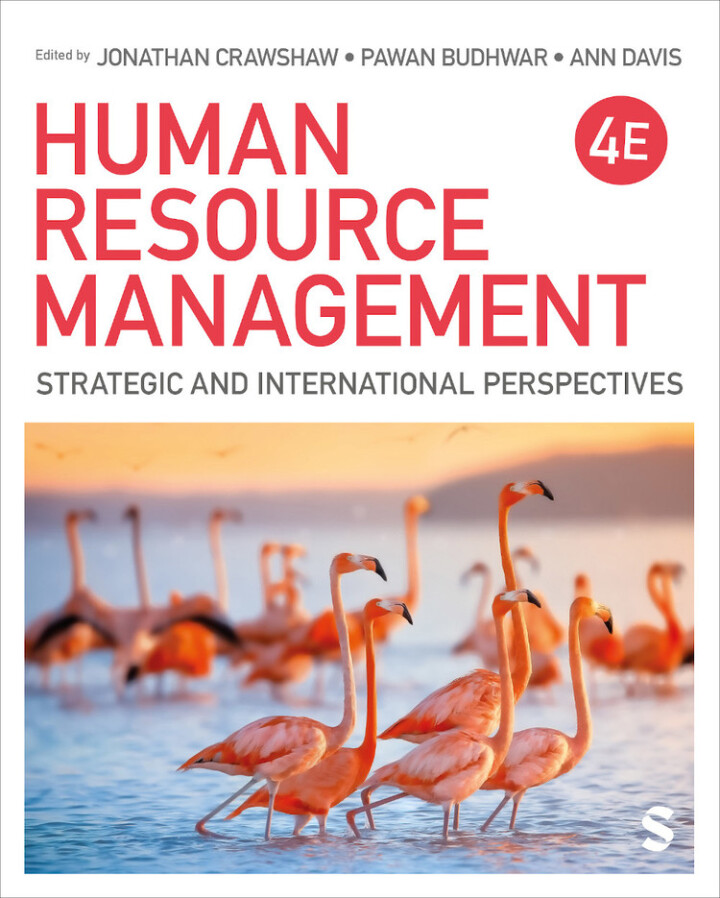
Human Resource Management 4th Edition - Strategic and International Perspectives
PUBLISHER: Sage
Trường ĐH, Nhóm, Thư Viện: Gọi 0915920514 để báo giá eBook hosting trên Vital Source hoặc mua Sách In
Quản trị nhân sựQuan điểm chiến lược và quốc tếVăn bản phổ biến này coi các vấn đề quốc tế, chiến lược và đương đại là trọng tâm của việc nghiên cứu và thực hành Quản lý nguồn nhân lực. Trọng tâm thực tế của nó giúp bạn phát triển các kỹ năng cần thiết cho thế giới công việc, thông qua việc học các tính năng như HRM trong thực tiễn, Phát triển các kỹ năng chính và Tranh luận về HRM. Ấn bản thứ tư đã được cập nhật kỹ lưỡng và mang đến cho bạn: • Các nghiên cứu điển hình đưa ra mối liên hệ giữa lý thuyết và những thách thức thực tế trong môi trường nhân sự quốc tế • Một chương mới về Sức khỏe tâm thần và Hạnh phúc liên quan đến công việc • Bao gồm các chủ đề tiên tiến như Tính đa dạng và Hòa nhập, Bền vững, Trí tuệ nhân tạo và Trách nhiệm xã hội của doanh nghiệp • Những hiểu biết MỚI về Tương lai và Xem xét các tính năng Bền vững Jonathan R. Crawshaw là Giảng viên cao cấp (Phó Giáo sư) và Giám đốc Nghiên cứu Khoa Tổ chức và Công việc tại Trường Kinh doanh Aston, Đại học Aston. Pawan Budhwar là Giáo sư kỷ niệm 50 năm ngành Quản trị nhân sự quốc tế tại trường Kinh doanh Aston. Ann Davis là Giáo sư và Phó Trưởng khoa Nguồn lực Học thuật và Phát triển tại Trường Kinh doanh Đại học Sydney.
List of FiguresList of TablesNotes on the Editors and ContributorsPrefaceStructure of the BookPedagogical FeaturesAcknowledgementsGuided TourOnline ResourcesFor LecturersPART ONE STRATEGIC ISSUES IN HRM1 Introduction: Context and Challenges for HRMIntroductionWhat is HRM?The Evolution of HRMCritical Perspectives on HRMHRM Roles and Responsibilities in OrganisationsOrganising the HR FunctionContemporary HR ChallengesChapter SummaryReview Questions and ExercisesExplore Further2 HRM and Firm PerformanceIntroductionStrategic ManagementStrategic Human Resource ManagementModelling HRM and Firm PerformanceResearching the HRM–Firm Performance RelationshipChapter SummaryReview Questions and ExercisesExplore Further3 Organisational Change and HRMIntroductionContent Versus Process of ChangeOrganisational Context and ChangeTypes of Change and Change PathsThe Change Process: Models and ToolsBehavioural ChangeCulture ChangeThe Roles of HR in Managing and Delivering ChangeChapter SummaryReview Questions and ExercisesExplore Further4 Digitisation, Artificial Intelligence (AI) and HRMIntroductionDigitisation and HRMArtificial Intelligence and HRMChapter SummaryReview Questions and ExercisesExplore Further5 Ethics and HRMIntroductionEthics and HRM: Theories and ConceptsCorporate Social ResponsibilityEthics and HR Policies and PracticesThe Ethical Dilemmas of New TechnologyEthics and HRM: Context and ConstraintsConclusionChapter SummaryReview Questions and ExercisesExplore Further6 Globalism, Multinational Enterprises and HRMIntroductionGlobalisation and MNEsMNEs and HRMLocalisation versus StandardisationDevelopment of HRM Systems in MNEsApproaches to HRM in MNEsKey HR Challenges in Global and Emerging MarketsChapter SummaryReview Questions and ExercisesExplore Further7 Employee Work-Related Mental Health and Well-BeingIntroductionThe Job Demands Resources ModelThe IPO Model of StressThe Input – Job StressorsThe Process – Psychological MechanismsThe Output – Stress ReactionsJob Resources – Factors that can Change the Relationship between Job Stressors and Stress ReactionsDesigning, Delivering and Evaluating Oragnisational Work-Related Health and Well-Being ProgrammesChapter SummaryReview Questions and ExercisesExplore FurtherPART TWO HRM IN PRACTICE8 Workforce Intelligence PlanningIntroductionA History of WIPWIP Aims and ActivitiesThe HR Function and WIPThe Theoretical and Empirical Basis of WIPA Critique of WIP: EvaluationChapter SummaryReview Questions and ExercisesExplore Further9 Recruitment and Selection: Diversity, Sustainability and Artificial IntelligenceIntroductionRecruitment and Selection: A Brief OverviewArtificial Intelligence and Recruitment and SelectionRecruitment and Selection for DiversityRecruitment and Selection for SustainabilityChapter SummaryReview Questions and ExercisesExplore Further10 Diversity and HRMIntroductionSome Key TermsThe Evolution of the Concept of Diversity and its Implications for OrganisationsAge Diversity and InclusivityHRM Practices for Diversity and InclusionChapter SummaryReview Questions and ExercisesExplore Further11 Learning and DevelopmentIntroductionThe Nature of LearningTheoretical Perspectives on LearningFormal and Informal Workplace LearningLearning EffectivenessThe Systematic Training CycleLearning and Development StrategyChapter SummaryReview Questions and ExercisesExplore Further12 Reward Strategies and SystemsIntroductionThe Significance of Pay Policy to HRMThe Purposes of RewardFairness in RewardStrategic and Total RewardWhat Do We Pay For?Recent and Current Issues for RewardChapter SummaryReview Questions and ExercisesExplore Further13 Performance Management and MotivationIntroductionPerformance Management: Purposes and ProcessesPerformance Management and Employee MotivationThe Supervisor–Subordinate RelationshipPerformance Management Systems in MNEsChapter SummaryReview Questions and ExercisesExplore Further14 Workplace Relations and RegulationsIntroductionWhat is the Employment Relationship?The Growth of LegislationThe Impact of Growing LegislationLegislation and the Balance of PowerThe Role of the Trade Unions in Regulating the Employment RelationshipBargaining and NegotiationParticipation and InvolvementThe Employment TribunalChapter SummaryKey StatutesReview Questions and ExercisesExplore FurtherGlossary of TermsReferencesIndex















